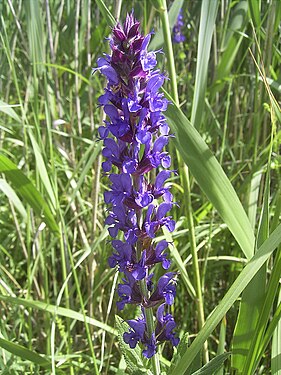Salvia nemorosa
| Habit | herbaceous
| |
|---|---|---|
| Height: | ⇕ | 24 in"in" can not be assigned to a declared number type with value 24. to 36 in"in" can not be assigned to a declared number type with value 36. |
| Width: | ⇔ | 12 in"in" can not be assigned to a declared number type with value 12. to 24 in"in" can not be assigned to a declared number type with value 24. |
| Lifespan: | ⌛ | perennial |
| Bloom: | ❀ | early summer, mid summer, late summer, early fall, mid fall, late fall |
| Exposure: | ☼ | sun |
|---|---|---|
| Features: | ✓ | flowers |
| USDA Zones: | 5 to 10 | |
| Flower features: | ❀ | blue, purple |
|
Salvia > |
nemorosa > |
L. > |
Salvia nemorosa (Woodland sage) is a hardy herbaceous perennial plant native to a wide area of central Europe and western Asia. It is an attractive plant that is easy to grow and propagate, with the result that it has been passed around by gardeners for many years. Its wide distribution, long history, and the ease with which it hybridizes have resulted in many cultivars and hybrids—along with problems in clearly identifying the hybrids and their relationship with S. nemorosa. It was named and described by Carl Linnaeus in 1762, with "nemorosa" ("of woods") referring to its typical habitat in groves and woods.[1]
In northern Britain, Salvia nemorosa and Salvia pratensis are both in danger of disappearing due depredation from slugs.[2]
There are numerous cultivars widely grown in horticulture. Many of them are hardy to –18 °C., with flowers ranging in color from violet, to violet-blue, rosy pink, and even white. All are perennial, with numerous leafy stems growing from the base at the beginning of summer. The many inflorescences have closely spaced whorls of small flowers with brightly colored calyces. The plant prefers full sun, good drainage, and moderate weekly watering.[1]
Read about Salvia nemorosa in the Standard Cyclopedia of Horticulture
|
|---|
|
Salvia nemorosa, Crantz (S. virgata., Hort., not Ait. S. virgata nemorosa, Hort.). Fig. 3537. Perennial, 2-3 ft. high, much branched: radical lvs. short-petioled, cauline sessile, lanceolate, 2 1/2-3 in. long, the upper lvs. gradually reduced in size, glabrous and dull green above, pale and finely pubescent beneath: fls. small, in very long slender spikes terminating all the branches, up to 16 in. long; floral whorls approximate, 6-fld.; corolla bright violet or purple. June-Oct. Eu. and W. Asia.—The fls. are sometimes described as being bronzy purple. Var. alba, Hort., is said to grow 18 in. high and to have short spikes of white fls. This may be the same as S. sylvestris var. alba, as S. nemorosa, Linn., is a synonym of S. sylvestris.
|
Cultivation
Propagation
Pests and diseases
Varieties
Gallery
References
- ↑ 1.0 1.1 Clebsch, Betsy; Carol D. Barner (2003). The New Book of Salvias. Timber Press. p. 208. ISBN 9780881925609. http://books.google.com/books?id=NM0iwB8GrQYC&pg=PA208.
- ↑ Fieldhouse, Ken; James Hitchmough (2004). Plant User Handbook: A Guide to Effective Specifying. Blackwell Publishing. pp. 334–335. ISBN 9780632058433. http://books.google.com/books?id=VtWpIjO7SgcC&pg=PA334.
External links
- w:Salvia nemorosa. Some of the material on this page may be from Wikipedia, under the Creative Commons license.
- Salvia nemorosa QR Code (Size 50, 100, 200, 500)



